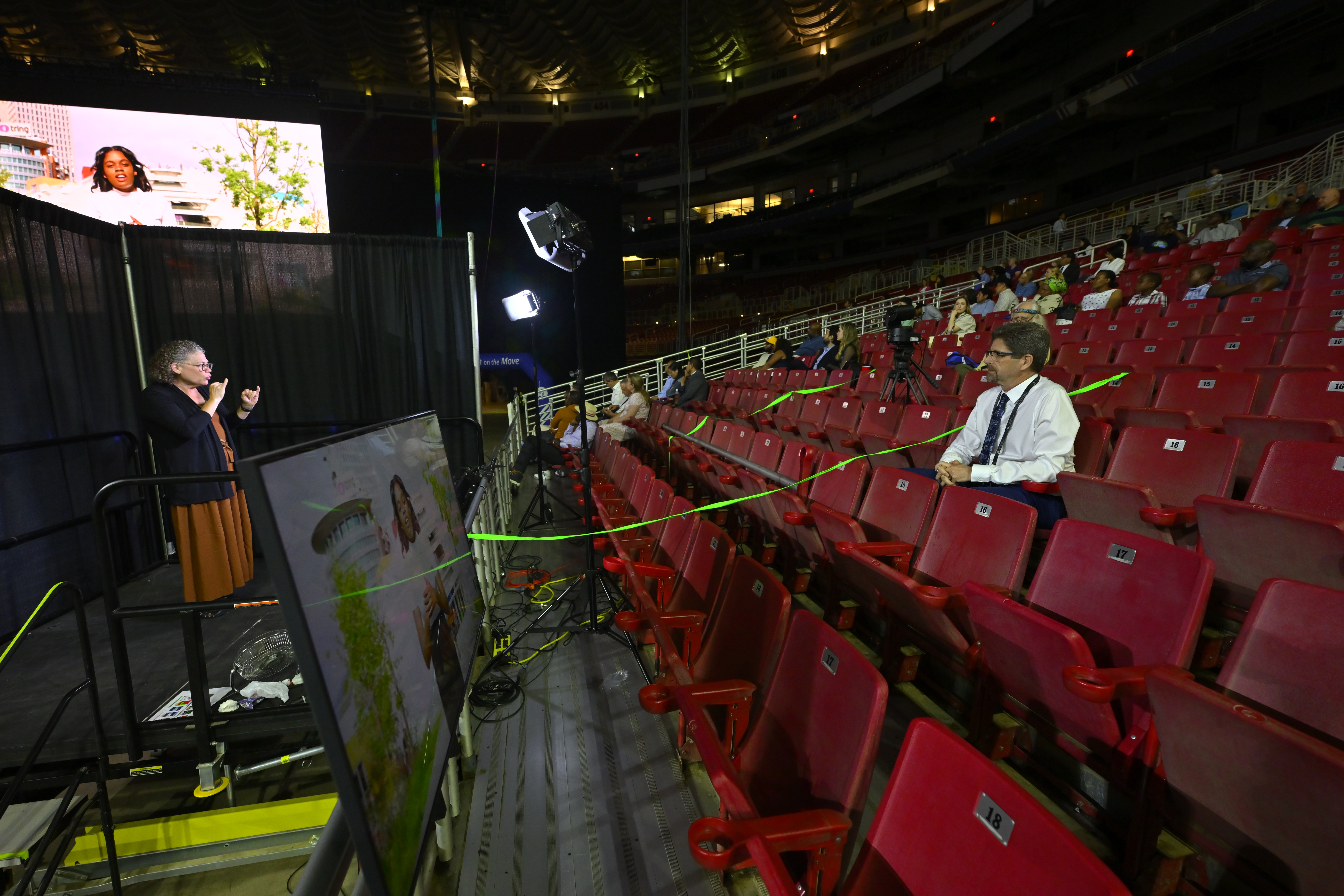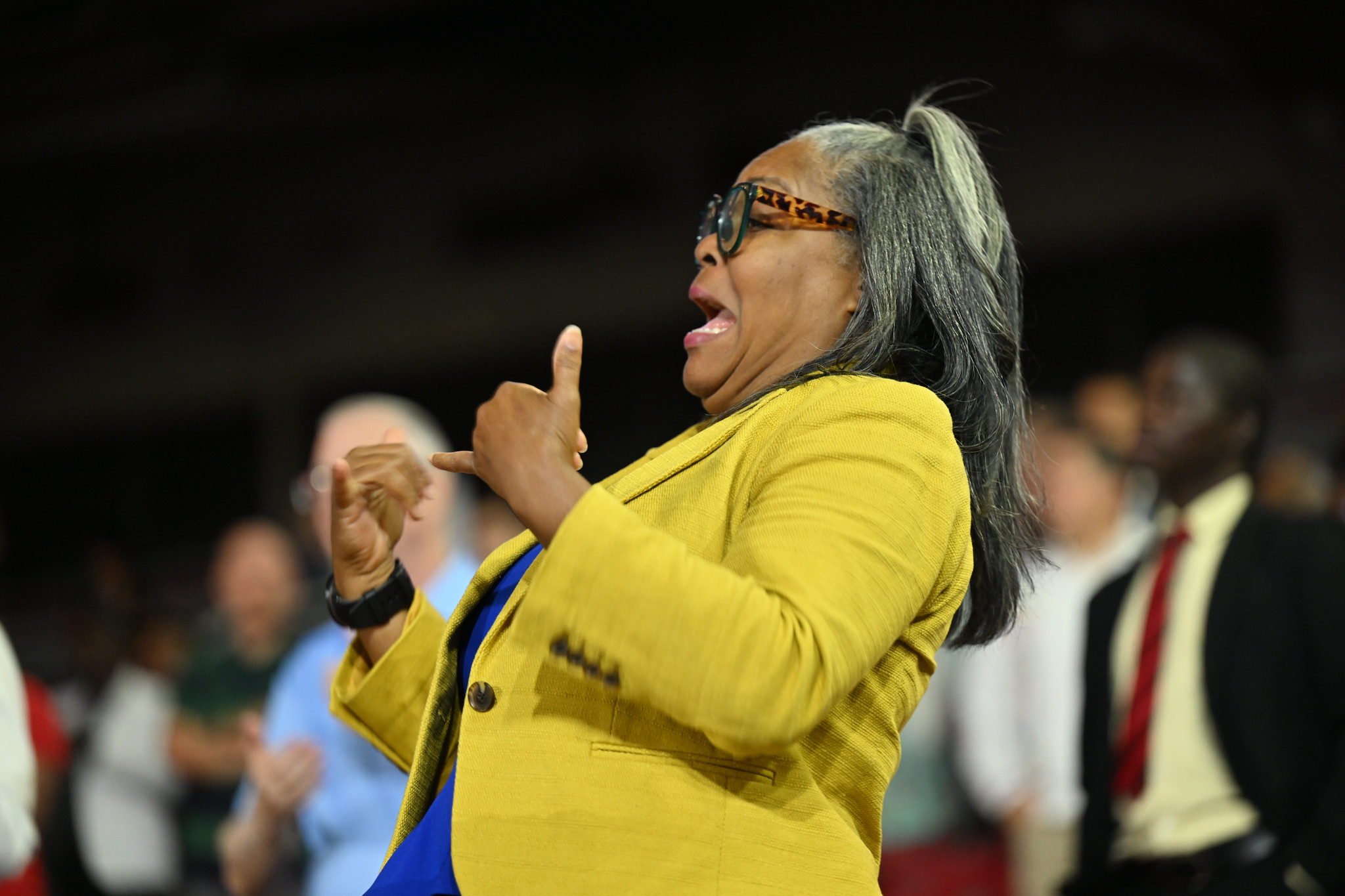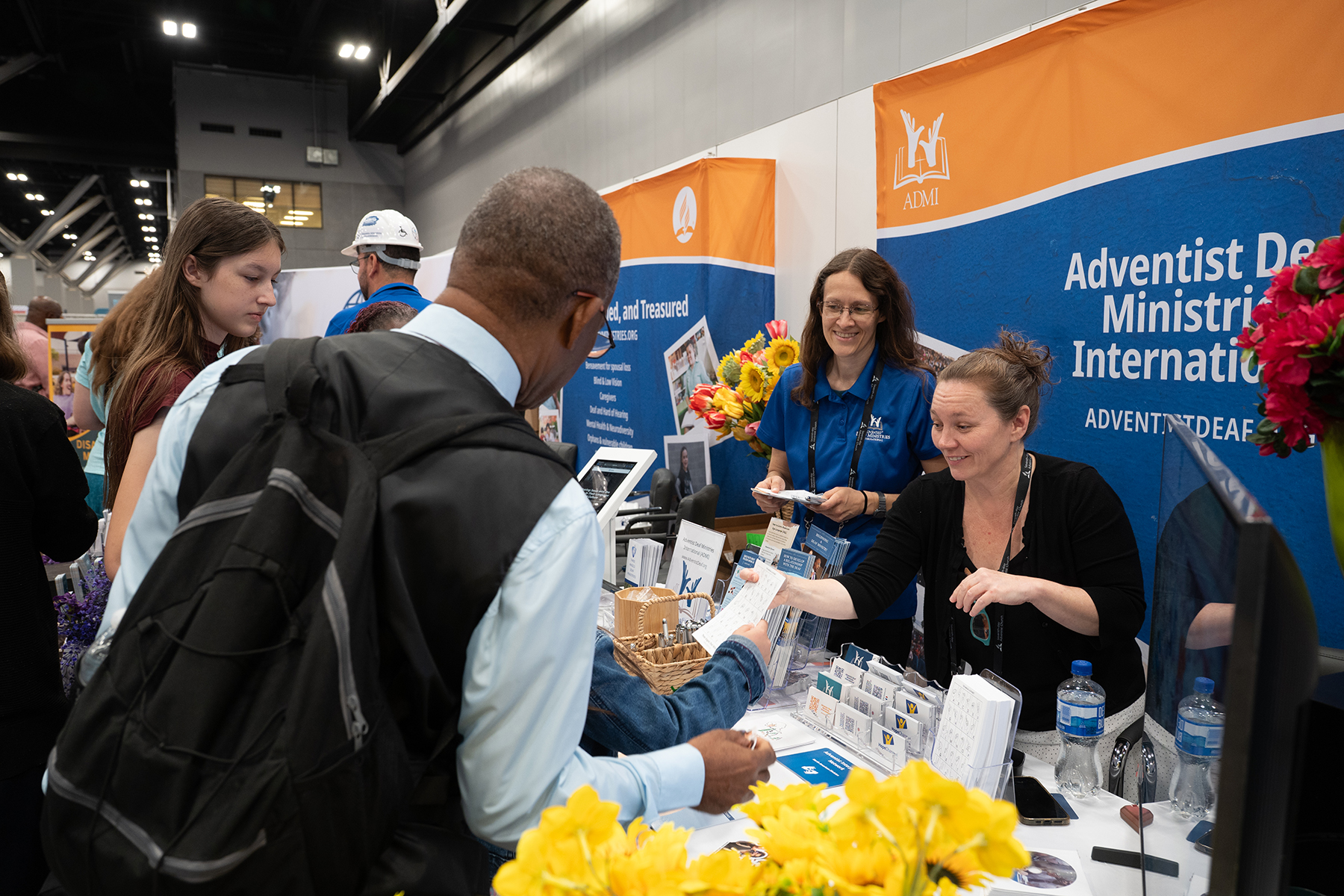
Jeff Jordan, pastor of the Southern Deaf Fellowship in Tennessee, was the only Deaf delegate at the 2025 GC Session. Here, he watches an interpreter during a business meeting. Photo: Ronald Pollard | North American Division
A quiet yet impactful movement continues to unfold at General Conference (GC) sessions — one not shaped by spoken words but by hands in motion. As thousands gathered for this global event of the Seventh-day Adventist Church, a spirit of inclusivity was clearly present through the work of American Sign Language (ASL) interpreters from the North American Division (NAD) and the dedicated advocates who supported them behind the scenes.
According to the World Health Organization, a deaf person typically experiences “profound hearing loss, which implies little to no hearing.” In North America alone, approximately 2 million people identify as Deaf. To ensure every participant could engage fully, GC Session organizers provided interpretation in multiple languages — including ASL — for business meetings and worship services.
Representation on the Delegate Floor
Among the 2,809 delegates to the 2025 GC Session, one participant held a particularly significant role: Jeff Jordan was the only one who is Deaf. Jordan, who pastors the Southern Deaf Fellowship near Collegedale, Tennessee, is also associate coordinator for the General Conference’s Adventist Possibility Ministries (APM). He first served as a delegate in 2022.
“Having a Deaf representative who has a ‘voice’ to represent them is important, especially during the GC Session. It is indeed an honor to represent my people group,” said Jordan.
Making his participation possible — and ensuring access for other Deaf attendees — required careful preparation. Adventist Deaf Ministries International (ADMI), a global ministry under APM, appointed Noheilani Jarnes of the Washington Conference to coordinate the ASL interpreter team. This year marked her third time in that role.
Over the years, Jarnes has seen the program grow and evolve. “The responsibility of the interpreter changed. We … now have to make sure that we are really on our game because Pastor Jordan has to be involved in the discussion [about] whatever he’s voting on. He has to know accurately what it is he is voting on,” she explained.

Monica Mack, interpreter from the Allegheny East Conference, signs during the 2025 GC Session. Photo: Bryant Taylor | Southern Union
Skilled Hands at Work
Behind the scenes, Jarnes led a team of seven certified interpreters, each trained to faithfully convey complex spiritual and procedural content for Deaf participants on-site and watching online via livestream. One of the interpreters, Monica Mack from the Allegheny East Conference, described the work as a labor of love but mentally demanding: “With the scriptures and the reports, and all of that, it’s very taxing.”
Interpreting is a highly dynamic process. “An interpreter’s brain functions very differently from most people,” said Jarnes. “When I’m interpreting, I’m listening to the message; I’m putting it on my hands to a Deaf person…at the same time, I’m listening to the message to hear what’s coming next, and I’m thinking about that interpretation.”
And it’s not just the hands that do the talking. Interpreting involves the entire body — leaning forward or backward can indicate past, present, or future tense, while facial expressions convey emotion and nuance. To stay mentally sharp and avoid fatigue, interpreters typically rotate every 15 minutes.
Each team member must pass a rigorous certification exam administered by an external organization. Some interpreters are “native language users,” meaning they grew up in Deaf households and learned ASL as their first language. “When you have native users, you have a more faithful rendering of the message to the Deaf,” Jarnes noted.
For Jordan, the team’s presence is more than a service — it’s essential for him to participate fully. “The world church has acknowledged that there is a Deaf people group worldwide and that electing a delegate to represent them is imperative. Communication is a major obstacle that I face daily. But because of seven sign language interpreters, I have been able to communicate with the hearing. When the interpreter interprets, I am able to ‘hear’ through my eyes.”
Ministry Beyond the Meetings

Amanda Colgan (left), director of Three Angels Deaf Ministries, and another exhibitor engage with visitors at the ADMI booth during the GC Session. Photo: Bryant Taylor | Southern Union
While the interpreters ensured access to the main program, ADMI and APM volunteers were busy connecting with attendees in the exhibit hall. Their booths welcomed thousands of visitors, offering resources and guidance on how local churches can better engage with and minister to Deaf individuals.
Interpreters such as Michelle Norris facilitated conversations between booth visitors and Deaf volunteers. These interactions helped many attendees understand the need for intentional, inclusive ministry in their own communities.
And that ministry is urgently needed. Only about 2 percent of Deaf individuals identify as Christian. “The Deaf people are one of the most unreached people groups in the world,” said Amanda Colgan, director of Three Angels Deaf Ministries (3ADM). “All the Deaf people need to know that Jesus loves them. It’s quite a challenge, and we are here to partner with you because we need your help doing the work.”
Colgan encourages churches to begin with simple, welcoming gestures. “You can write back and forth with them if you don’t know sign language,” she said. She also suggests captioning livestreams, providing sermon scripts, or sitting next to Deaf guests and helping them follow along with hymns or responsive readings. “They are just small things that you can do along the way to help them feel a part of the service.” (Visit 3ADM.org for resources and sharing videos.)
Expanding the Work
Jordan is hopeful that this global spotlight on Deaf ministries will lead to greater action at the local level. “We have APM directors in all 13 divisions. It is a worldwide movement, and that’s exciting! But, as the saying goes, the harvest is plentiful, but the workers are few. We need more workers to help spread the gospel to the Deaf.”
— Debra Banks Cuadro is the communication director for the Atlantic Union Conference.
